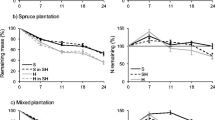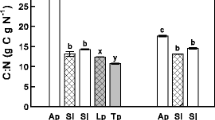Abstract
Aims
Shrub encroachment in mesic grasslands alters the identity and quality of litters entering the system. As litter from shrubs and grasses can differ in their quality, this can lead to differences in litter decomposition by the direct effect of quality, but also to litter interaction during decomposition. The objective of this study was to examine the occurrence of non-additive effects of litter mixtures on the decomposition rates of legume shrub litter (poor in P) or conifer shrub litter (poor in N) and grass litter.
Methods
In addition to single litter type litterbags for the three species, we mixed litters of each pair of possible combinations to determine the influence of each species on mass loss. Litterbags were placed in the field and collected after 1, 6, 8, 12 and 24 months. In each collection, litter of each species remaining in mixed bags was separated, dry weighed and analyzed for C, N and P.
Results
With respect to shrub litter decomposing alone, mass loss of shrub litter when mixed with grass showed a 9–10 % increase in decomposition rate for conifer and a 3 % increase for legume litter. These litter mixture effects varied with time and they were detected after a decomposition period of 1 year in legume litter and of 2 years in conifer litter.
Conclusions
Grass litter hastened conifer and legume litter decomposition in leaf litter mixtures, at least during the first stages of the process. The potential consequences of this result to alter litter accumulation patterns and thus carbon sequestration rates after shrub encroachment into grasslands will depend on whether the observed trends are maintained in the advanced decomposition stages.



Similar content being viewed by others
References
Archer S, Schimel DS, Holland EA (1995) Mechanisms of shrubland expansion: land use, climate or CO2? Clim Change 29:91–99
Asner GP, Eldmore AJ, Olander LP, Martin RE, Harris AT (2004) Grazing systems, ecosystem responses, and global change. Annu Rev Environ Resour 29:261–299
Ball BA, Hunter MD, Kominoski JS, Swan CM, Bradford MA (2008) Consequences of non-random species loss for decomposition dynamics: experimental evidence for additive and non-additive effects. J Ecol 96:303–313
Berg B, McClaugherty C (2003) Plant litter: decomposition, humus formation, carbon sequestration. Springer Verlag, Heidelberg
Berg B, Staaf H (1980) Decomposition rate and chemical changes of Scotts pine needle litter. II Influence of chemical composition. Ecol Bull 32:373–390
Blair JM, Parmalee W, Baere MH (1990) Decay rates, nitrogen fluxes, and decomposer communities of single—and mixed- species foliar litter. Ecology 71:1976–1985
Bonanomi G, Incerti G, Antignani V, Capodilupo M, Mazzoleni S (2010) Decomposition and nutrient dynamics in mixed litter of Mediterranean species. Plant Soil 331:481–496
Briggs JM, Knapp AK, Blair JM, Heisler JL, Hoch GA, Lett MS, McCarron JK (2005) An ecosystem in transition: causes and consequences of the conversion of mesic grassland to shrubland. BioScience 55:243–254
Chapman SK, Newman GS (2010) Biodiversity at the plant-soil interface: microbial abundance and community structure respond to litter mixing. Oecologia 162:763–769
Chigineva NI, Aleksandrova AV, Marshan S, Kandeler E, Tiunov AV (2011) The importance of mycelial connection at the soil-litter interface for nutrient translocation, enzyme activity and litter decomposition. Appl Soil Ecol 51:35–41
Day RW, Quin GP (1989) Comparison of treatments after an analysis of variance in ecology. Ecol Monogr 59:433–463
De Marco A, Meola A, Maisto G, Giordano M, De Santo AV (2011) Non-additive effects of litter mixtures on decomposition of leaf litters in a Mediterranean maquis. Plant Soil 344:305–317
Fang J, Chen A, Peng C, Zhao S, Ci L (2001) Changes in woodland biomass carbon storage in China between 1949 and 1998. Science 292:2320–2322
Gartner TB, Cardon ZG (2004) Decomposition dynamics in mixed-species leaf litter. Oikos 104:230–246
Gessner MO (1991) Differences in processing dynamics of fresh and dried leaf litter in a stream ecosystem. Freshwater Biol 26:387–398
Gessner MO, Swan CM, Dang CK, McKie BG, Bardgett RD, Wall DH, Hättenschwiler S (2010) Diversity meets decomposition. Trends Ecol Evol 25:372–380
Gracia M, Montané F, Piqué J, Retana J (2007) Overstory structure and topographic gradients determining diversity and abundance of understory shrub species in temperate forests in central Pyrenees (NE Spain). For Ecol Manage 242:391–397
Gusewell S, Gessner MO (2009) N:P ratios influence litter decomposition and colonization by fungi and bacteria in microcosms. Funct Ecol 23:211–219
Hättenschwiler S (2005) Effects of tree species diversity on litter quality and decomposition. In: Scherer-Lorenzen M, Körner C, Schulze ED (eds) Forest Diversity and Function: Temperate and Boreal Systems. Springer, Berlin Heidelberg
Hättenschwiler S, Tiunov AV, Scheu S (2005) Biodiversity and litter decomposition in terrestrial ecosystems. Annu Rev Ecol Evol S 36:191–218
Hoorens B, Stroetenga M, Aerts R (2010a) Litter mixture interactions at the level of plant functional types are additive. Ecosystems 13:90–98
Hoorens B, Coomes D, Aerts R (2010b) Neighbour identity hardly affects litter-mixture effects on decomposition rates of New Zealand forest species. Oecologia 162:479–489
Jackson RB, Banner JL, Jobbágy EG, Pockman WT, Wall DH (2002) Ecosystem carbon loss with woody plant invasion of grasslands. Nature 418:623–626
Klemmedson JO (1992) Decomposition and nutrient release from mixtures of gamel oak and ponderosa pine leaf litter. For Ecol Manage 47:649–661
Lecerf A, Marie G, Kominoski JS, LeRoy CJ, Bernadet C, Swan CM (2011) Incubation time, functional litter diversity, and habitat characteristics predict litter-mixing effects on decomposition. Ecology 92:160–169
Liu P, Sun OJ, Huang J, Li L, Han X (2007) Nonadditive effects of litter mixtures on decomposition and correlation with initial litter N and P concentrations in grassland plant species of northern China. Biol Fertil Soils 44:211–216
Madritch MD, Cardinale BJ (2007) Impacts of tree species diversity on litter decomposition in northern temperate forests of Wisconsin, USA: a multi-site experiment along a latitudinal gradient. Plant Soil 292:147–159
Maestre FT, Bowker MA, Puche MD, Hinojosa MD, Martínez I, García-Palacios P, Castillo AP, Soliveres S, Luzuriaga AL, Sánchez AM, Carreira JA, Gallardo A, Escudero A (2009) Shrub encroachment can reverse desertification in semi-arid Mediterranean grasslands. Ecol Lett 12:930–941
Manzoni S, Trofymow JA, Jackson RB, Porporato A (2010) Stoichiometric controls on carbon, nitrogen, and phosphorus dynamics in decomposing litter. Ecol Monogr 80:89–106
Meier CL, Bowman WD (2010) Chemical composition and diversity influence non-additive effects of litter mixtures on soil carbon and nitrogen cycling: implications for plant species loss. Soil Biol Biochem 42:1447–1454
Montané F, Rovira P, Casals P (2007) Shrub encroachment into mesic grasslands in the Iberian peninsula: effects of plant quality and temperature on soil C and N stocks. Glob Biogeochem Cycles 21:GB4016. doi: 10.1029/2006GB002853
Montané F, Romanyà J, Rovira P, Casals P (2010) Aboveground litter quality changes may drive soil organic carbon increase after shrub encroachment into mountain grasslands. Plant Soil 337:151–165
Moore TR, Trofymow JA, Prescott CE, Titus BD (2011) Nature and nurture in the dynamics of C, N and P during litter decomposition in Canadian forests. Plant Soil 339:163–175
Ninyerola M, Pons X, Roure JM (2000) A methodological approach of climatological modelling of air temperature and precipitation through GIS techniques. Int J Climatol 20:1823–1841
Perez Harguindeguy N, Blundo CM, Gurvich DE, Díaz S, Cuevas E (2008) More than the sum of its parts? Assessing litter heterogeneity effects on the decomposition of litter mixtures through leaf chemistry. Plant Soil 303:151–159
Prescott CE (2005) Decomposition and mineralization of nutrients from litter and humus. In: BassiriRad H (Ed) Nutrient acquisition by plants. An ecological perspective. Springer-Verlag, pp 15–41
Prescott CE, Zabek LM, Staley CL, Kabzerns R (2000) Decomposition of broadleaf and needle litter in forests of British Columbia: influences of litter type, forest type, and litter mixtures. Can J Forest Res 30:1742–1750
Quested HM, Cornelissen JHC, Press MC, Callaghan TV, Aerts R, Trosien F, Riemann P, Gwynn-Jones D, Kondratchuk A, Jonasson SE (2003) Decomposition of sub-arctic plants with nitrogen economics: a functional role for hemiparasites. Ecology 84:3209–3221
Schimel JP, Hattenschwiler S (2007) Nitrogen transfer between decomposing leaves of different N status. Soil Biol Biochem 39:1428–1436
Seastedt TR (1984) The role of microarthropods in decomposition and mineralization processes. Annu Rev Entomol 29:25–46
Soil Survey Staff (1999) Soil taxonomy: a basic system of classification for making and interpreting soil surveys. Agricultural Handbook 436, 2nd edn. USDA, Washington
Staaf H (1980) Influence of chemical composition, addition of raspberry leaves, and nitrogen supply on decomposition rate and dynamics of nitrogen and phosphorus in beech leaf litter. Oikos 35:55–62
Throop HL, Archer SR (2007) Interrelationships among shrub encroachment, land management, and litter decomposition in a semidesert grassland. Ecol Appl 17:1809–1823
Van Auken OW (2009) Causes and consequences of woody plant encroachment into western North American grasslands. J Environ Manage 90:2931–2942
Vivanco L, Austin AT (2011) Nitrogen addition stimulates forest litter decomposition and disrupts species interactions in Patagonia, Argentina. Global Change Biol 17:1963–1974
Wardle DA, Bonner KI, Nicholson KS (1997) Biodiversity and plant litter: experimental evidence which does not support the view that enhanced species richness improves ecosystem function. Oikos 79:247–258
Wardle DA, Nilsson M-C, Zackrisson O, Gallet C (2003) Determinants of litter mixing effects in a Swedish boreal forest. Soil Biol Biochem 35:827–835
Wardle DA, Bardgett RD, Walker LR, Bonner KI (2009) Among- and within-species variation in plant litter decomposition in contrasting long-term chronosequences. Funct Ecol 23:442–453
Acknowledgments
FM was supported by a grant (2005FI 00801) from the DURSI-Generalitat de Catalunya and the European Social Fund. Additional support came from the Spanish Ministerio de Educación y Ciencia (VULCA, CGL2005-08133-CO3) and by the European Commission under the GHG-Europe project (FP7-ENV-2009-1, project No. 244122). FMA helped in the field. The authors thank the Alt Pirineu Natural Park for allowing them to work in the Campirme study site. JR, PR and PC are members of the GRACCIE Research Net (Consolider Program, Ministerio de Ciencia e Innovación, Spain; CSD2007-00067). PR and PC are supported by Ramón y Cajal Contracts (Ministerio de Economia y Competitividad, Spain).
Author information
Authors and Affiliations
Corresponding author
Additional information
Responsible Editor: Tim Moore.
Rights and permissions
About this article
Cite this article
Montané, F., Romanyà, J., Rovira, P. et al. Mixtures with grass litter may hasten shrub litter decomposition after shrub encroachment into mountain grasslands. Plant Soil 368, 459–469 (2013). https://doi.org/10.1007/s11104-012-1533-8
Received:
Accepted:
Published:
Issue Date:
DOI: https://doi.org/10.1007/s11104-012-1533-8




